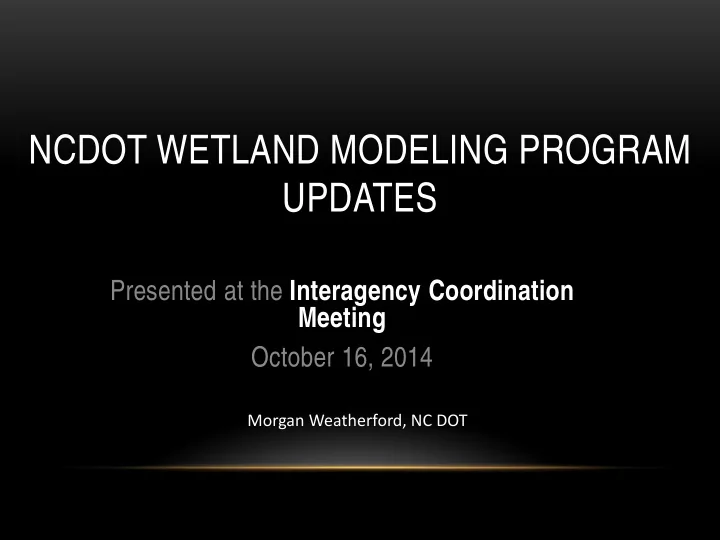

NCDOT WETLAND MODELING PROGRAM UPDATES Presented at the Interagency Coordination Meeting October 16, 2014 Morgan Weatherford, NC DOT
PURPOSE AND NEED NCDOT’s Streamlined Project Development Process includes GIS-based • impact projections Existing GIS data sources are not of sufficient quality => all proposed • corridors must be field surveyed => more time and money Examples: • • USFWS National Wetland Inventory (NWI) • USGS 1:24,000 scale streamlines • NRCS Soil Survey Maps
PURPOSE AND NEED Produce high quality GIS data that is accurate and consistent enough • to compare alternatives Reduce field work, costs and project delivery times • NCDOT goal of requiring full field delineations only for LEDPA • corridor. Three pilot projects established: Carthage, Kinston, and ? (originally • Dillsboro Bypass)
PILOT PROJECT - CARTHAGE Carthage bypass, TIP R-2212, is the first proposed pilot • project Located in Moore Co. • Triassic Basins and Sandhills ecoregions • Wetland and headwater stream models developed and applied • Accuracy assessed • Results were used to determine utility and feasibility of • expansion of modeling efforts to other pilot projects and eventually the entire state
RESULTS CARTHAGE
RESULTS CARTHAGE (BY CORRIDOR)
PILOT PROJECT – KINSTON BYPASS Kinston bypass, TIP R-2553, is the second proposed pilot • project Located in Lenoir Co. • Rolling Coastal Plains, Southeaster Floodplains/Low Terraces • and Carolina Flatwoods ecoregions Wetland and headwater stream models developed and applied • Updated ~30 layers for the entire county to help choose • LEDPA Developed GIS-based NRTR • Developed remote-assessment for stream crossings for CP2A • Developed county-wide ditch model to estimate lateral effect – • to be determined how to use appropriately
RESULTS KINSTON
Initial Route Options Developed STIP Project No. R-2553
21 DSAs Refined and Narrowed to 17 (follow-up to CP2) STIP Project No. R-2553
17 DSAs Narrowed Down to 12 at CP2 Revisited
KINSTON BYPASS • Allows for consideration/evaluation of a large amount of initial alternatives • Can easily quantify impacts of new alternatives or revised alternatives • Allows for design revisions “outside of the corridor” without the need for additional field work – Avoidance and minimization of impacts by shifting roadway and interchanges – Late addition of Shallow Bypass alternative based on public input STIP Project No. R-2553
KINSTON BYPASS Stream and Wetland LiDAR based models developed to produce GIS data layers – Time and cost savings $250,000 = Stream and Wetland GIS data layers VS $600,000 = Traditional field delineation – Model results extend beyond project study area – Can be used for other projects (Carey Road Ext) – Kinston results applicable to three ecoregions me and c – SOS to CP2A (10/2009 to 4/2014) 53* months vs. 69 month avg. = a savings of 16 months STIP Project No. R-2553
R-2609 - US 401 IMPROVEMENTS From Fayetteville to Fuquay-Varina • Not Pilot Project • Applying what was developed for Kinston Bypass • Using to review alternatives for CP2 • Sandhills, SFLT, Rolling Coastal Plain, Northern Outer Piedmont •
GENERAL METHODS Field data Model Development (SAS, GIS) Terrain (GIS) data Mathematical model 1 / (1 + Exp(-39.1406 + ([asp] * -0.00214) + ([avgasp] * - 0.00187) + ([plan] * 0.9620) + ([avgplan] * -104.7) + ([avgprof] * 47.9643) + ([d8slp] * -7.9884) + ([avgd8slp] * 79.0305) + ([elev] * -0.00321) + ([plen] * -0.00015) + ([lntlen] * 3.0704)))
GENERAL METHODS Model applied to Field data test area Accuracy GIS stream lines or wetland polygons
DIGITAL ELEVATION MODEL (DEM) RASTER DEM overview (scale 1:100K) DEM detail (scale 1:285)
THINGS TO DO WITH DEMS: TERRAIN DERIVATIVES Elevation Slope
TERRAIN DERIVATIVE EXAMPLES Curvature Depression analysis
VARIABLES 12 Terrain Derivatives • Soils • LULC • Other Models • Post treatment variables • Requires ArcGIS w Spatial Analyst, Taudem, TAS, SAS • Can be time-consuming, need for automation •
CURRENT RESEARCH PROJECT Automated generation of terrain derivatives • One click wetland prediction • Refinement stage •
RESEARCH PROJECT
UPCOMING RESEARCH PROJECTS To expand on current wetland models • - NCWAM wetland type - Functional assessment (Not trying to duplicate NCWAM in GIS) To predict tidal wetlands using the new QL2 LiDAR •
QL2 LIDAR USGS/FPM captured 20 coastal counties earlier this year • 20 more counties (paid for by NCDOT) also earlier this year • 20 counties each year for the next three years • 0.59 ft. fundamental vertical accuracy at 95% confidence level • (open terrain) Nominal 2 points per meter • Intensity values • Point cloud classification •
QL2 LIDAR
QL2 LIDAR
QL2 LIDAR
QUESTIONS?
Recommend
More recommend